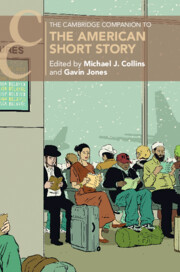56 results
VaTEST III: Validation of eight potential super-earths from TESS data
-
- Journal:
- Publications of the Astronomical Society of Australia / Volume 41 / 2024
- Published online by Cambridge University Press:
- 11 April 2024, e030
-
- Article
- Export citation
Part IV - Theories
-
- Book:
- The Cambridge Companion to the American Short Story
- Published online:
- 11 May 2023
- Print publication:
- 25 May 2023, pp 267-357
-
- Chapter
- Export citation
Part I - Contexts
-
- Book:
- The Cambridge Companion to the American Short Story
- Published online:
- 11 May 2023
- Print publication:
- 25 May 2023, pp 15-114
-
- Chapter
- Export citation
Copyright page
-
- Book:
- The Cambridge Companion to the American Short Story
- Published online:
- 11 May 2023
- Print publication:
- 25 May 2023, pp iv-iv
-
- Chapter
- Export citation
Contributors
-
- Book:
- The Cambridge Companion to the American Short Story
- Published online:
- 11 May 2023
- Print publication:
- 25 May 2023, pp x-xv
-
- Chapter
- Export citation
Index
-
- Book:
- The Cambridge Companion to the American Short Story
- Published online:
- 11 May 2023
- Print publication:
- 25 May 2023, pp 372-380
-
- Chapter
- Export citation
Further Reading
-
- Book:
- The Cambridge Companion to the American Short Story
- Published online:
- 11 May 2023
- Print publication:
- 25 May 2023, pp 363-371
-
- Chapter
- Export citation
Chronology
-
- Book:
- The Cambridge Companion to the American Short Story
- Published online:
- 11 May 2023
- Print publication:
- 25 May 2023, pp xvi-xxiv
-
- Chapter
- Export citation
Notes
-
- Book:
- The Cambridge Companion to the American Short Story
- Published online:
- 11 May 2023
- Print publication:
- 25 May 2023, pp 358-362
-
- Chapter
- Export citation
Part III - People and Places
-
- Book:
- The Cambridge Companion to the American Short Story
- Published online:
- 11 May 2023
- Print publication:
- 25 May 2023, pp 189-266
-
- Chapter
- Export citation
Part II - Histories
-
- Book:
- The Cambridge Companion to the American Short Story
- Published online:
- 11 May 2023
- Print publication:
- 25 May 2023, pp 115-188
-
- Chapter
- Export citation
Contents
-
- Book:
- The Cambridge Companion to the American Short Story
- Published online:
- 11 May 2023
- Print publication:
- 25 May 2023, pp v-vii
-
- Chapter
- Export citation
Tables
-
- Book:
- The Cambridge Companion to the American Short Story
- Published online:
- 11 May 2023
- Print publication:
- 25 May 2023, pp ix-ix
-
- Chapter
- Export citation
Introduction
-
-
- Book:
- The Cambridge Companion to the American Short Story
- Published online:
- 11 May 2023
- Print publication:
- 25 May 2023, pp 1-14
-
- Chapter
- Export citation
Figures
-
- Book:
- The Cambridge Companion to the American Short Story
- Published online:
- 11 May 2023
- Print publication:
- 25 May 2023, pp viii-viii
-
- Chapter
- Export citation

The Cambridge Companion to the American Short Story
-
- Published online:
- 11 May 2023
- Print publication:
- 25 May 2023
Cerebrospinal fluid neurofilament light predicts longitudinal diagnostic change in patients with psychiatric and neurodegenerative disorders
-
- Journal:
- Acta Neuropsychiatrica / Volume 36 / Issue 1 / February 2024
- Published online by Cambridge University Press:
- 28 April 2023, pp. 17-28
-
- Article
-
- You have access
- Open access
- HTML
- Export citation
Economic impacts of the COVID-19 crisis: evidence from credit and debt of older adults
-
- Journal:
- Journal of Pension Economics & Finance / Volume 23 / Issue 1 / January 2024
- Published online by Cambridge University Press:
- 09 November 2022, pp. 53-71
-
- Article
-
- You have access
- Open access
- HTML
- Export citation
A history of high-power laser research and development in the United Kingdom
- Part of
-
- Journal:
- High Power Laser Science and Engineering / Volume 9 / 2021
- Published online by Cambridge University Press:
- 27 April 2021, e18
-
- Article
-
- You have access
- Open access
- HTML
- Export citation
1 - Transnationalism and the Transatlantic Short Story
- from Part I - Historicising the Short Story
-
-
- Book:
- The Edinburgh Companion to the Short Story in English
- Published by:
- Edinburgh University Press
- Published online:
- 18 December 2019
- Print publication:
- 31 October 2018, pp 9-23
-
- Chapter
- Export citation



















